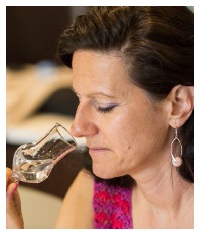
The word and concept of ‘pálinka’ for a wide range of audience is known in Hungary since the 1700´s. However a lot has changed in terms of the raw material for the production of pálinka over the centuries, thanks to the technological and agricultural backgrounds.
They brought the fact, that the noble drink got more attention, hence the culture of the pálinka consumption became richer, in which the consumer finds the right way. There are several interesting philosophies regarding the pálinka consumption, however it is worth considering in more detail the proper way of tasting, since the experience itself with every careful sip can change our opinion about pálinka for a lifetime.
It can further help us to differentiate between the unpleasant (faulty) and fine, excellent pálinkas as well as distinguish the aroma and flavour characteristics and create our own flavour preference too.
I found in a number of cases during presentations, how someone’s opinion can change into a positive direction about pálinka, just after an appropriate way of tasting.
A FEW KEY POINTS WORTH TO CONSIDER:
TEMPERATURE
Several trials have shown that the most ideal is the 20°C, as more than 1200 aroma components reveal themselves, hence this is the best temperature to experience the most in terms of aroma and flavours.
Pálinka should not be kept in the fridge. The average 5-10°C temperature mutes the aroma components, the experience will be lost. However, the cool temperature may help to subdue the flavour components in those pálinkas, which have been badly separated, the unwanted tail fraction is less visible in these, hence it tricks the consumer. If we don´t have a well-tempered chamber or cellar, the bottle of pálinka could well be placed for a short time into the fridge to chill it down to the right temperature, yet it is easier, if we place the glass into the fridge. The – warm – pálinka, poured in the chilled glass, has all the chance to reveal its beauty.
If the pálinka is cold – despite all the good intentions, it was in the fridge – and we are inpatient, we don’t have enough time to wait for the right temperature, rinse the glass with warm water – polish the glass dry – and sip it this way.
FORM OF THE GLASS
Similarly to other alcoholic beverages the main task is here as well, that the aromas of the pálinka reach the nose in their fullest form. The ideal glass is the one, which has a foot to stand on it, stem to hold it, the bowl has a tulip like shape, narrow at the bottom and at the rim slightly turning outside. The shape reassures the optimal interaction with the air, so that the aroma molecules can go up the nostrils during the tasting. The glass should be touched at either by the foot or the stem. With this we do two things: do not leave fingerprints on the bowl and we can enjoy the visual beauty of the pálinka, as well as it will not be warmed up by our hand.
The glass should never be filled completely, as the aroma molecules have to evaporate on the surface. The sum of the quantity in the glass should be – depending on the size of the glass – around 1.5 to 3 cl.
CONSUMPTION
Only that pálinka should be consumed, which scent, aroma we like! This means, let´s believe our nose. If there is an unpleasant aroma, as we have a different aroma preference, or it is a faulty fractioned pálinka, it does not have to be tasted. Non-competition judges must not put their opinion to the side, they can well say no to that pálinka.
However, if we like the aroma, we shall consume slowly, sip by sip and let it breathe as well. The majority of the pálinkas can be consumed straight after they are poured. On the other side there are aged and bedded samples, similar to the full-bodied red wine, they might need more time to open up. It´s worth to let them rest for 2-3 minutes after pouring.
There can be huge differences, if we bring the necessary patience! Contrary to wine, pálinkas are not ‘chased’ in the glass. Only a little of ‘swirling’ is allowed, at a stronger swirl alcohol comes to the surface and it will poke our nose and we feel a higher alcohol, than it actually is in reality. Just move it carefully, spread it evenly in the inner surface of the glass to increase the evaporation surface.
And now let´s taste. Take just a small sip into the mouth and let the pálinka run around on the palate, so it has a chance to evaporate further. The aromas thus return to the nose through the nostrils and are supplemented by a myriad of aroma components during swallowing. This experience cannot be beaten.
One trick to increase the experience – dry tasting: If the glass is empty, cover the bowl with your hand – here it’s allowed – to warm it slightly up, and thanks to the inner surface of the glass the aroma molecules show even more interesting things, enhancing the experience and supporting the memorization even further.
TO SUM IT UP: PÁLINKA SHOULD BE CONSUMED AT 20-22°C, OUT OF A GLASS – TULIP LIKE SHAPE – WITH FOOT, STEM, PROPER BOWL FORM AND SIP BY SIP ONLY.
WHEN SHOULD WE DRINK PÁLINKA?
If we look for the true culinary value, it’s best to consume it by matching to food, usually after a meal, because of its digestive properties.
Consumption with moderation can be part of any event in our life. The quality producers, distillers are artists in my opinion, who deserve that their art work to be honoured through sensible consumption, and the pálinkas of excellence demand this.
Have fun and new experiences!
Edit Szöllősi


